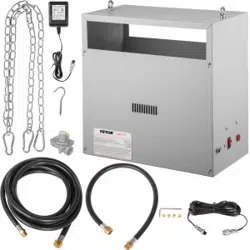Loading ...
Loading ...

connections.
5) Open the inline shut off valve (make sure the main is on). Check for leaks using soapy water and a spray
bottle. Look for bubbling, this indicates a leak.
6 ) Flip power switch to on position, within 20 sec. unit will begin to spark to ignite the fuel.
Connecting to CO
2
controller
NOTE: The recommended CO
2
level for optimum growth is between 1000 to 1500 PPM. Above these levels
is considered wasteful. Above 5000 PPM is considered dangerous to animals and humans. Side effects of
excessive CO
2
include headache, drowsiness & shortness of breath. Use a PPM controller to ensure you’re
maintaining proper PPM levels.
1) Connect the CO
2
generator’s power supply to the controller that you are using. Usage of the generator
should be during lights ON hours. At bare minimum, a timer can be used to turn the generator on/off.
Possibilities are likely to exceed recommended PPM range with this method.
2) Set CO
2
controller to desired PPM level and plug in the power of the CO
2
generator into the controller.
Lighting the Generator
1) Connect the power supply to the power connection on the side of the generator and plug it into the wall or
your CO
2
controller.
NOTE: Confirm that the supply voltage and plug voltage is the same.
2) Ensure the power switch on the side of unit is OFF. Turn on the gas supply to the unit.
3) Turn on the power switch. The generator will turn on the valve and attempt to light the generator. It will
make 5 attempts to light the main burner, 20 seconds apart. If the generator does not light the 5th attempt, a red
light will appear on the electric ignition module indicating that it was unable to light in 5th attempts. And give
alarm. It will not try again until the power is cycled. Turn off the power switch and turn it back on, it should
light with the next 5 attempts after all the air in the das line is gone. Depending on the length of the gas hose,
you might need to turn it on and off to 3 or 4 times, if your generator still will not light, please refer to the
troubleshooting tips at the end of this instruction manual.
4) Once the main burner lights, it is should light reliably until the tank (propane only) is changed out.
5) The red indicator light on the side of the generator and blue light on the ignition module is both on as long
as the main burner is running.
Proper Sizing
It is important to consider that some manufactures have inaccuracies within their generator ratings. In order to
compare sizes, a very simple conversion can be used to determine a CO
2
generator’s actual capacity to produce
CO
2
. That is assuming you know the actual Btu output of the unit. British thermal units (BTUs) are stated as
the actual heat output of the unit. Heat output (BTU), is determined simply by knowing the pressure of the gas,
the type of gas (LP or natural) and the volume of gas allowed to flow to the burner.
To convert an LP generator’s Btu rating into cubic feet of CO
2
per hour:
Btu / hr ×1.18
Example: 22,352×1.18 22,352 ×1.18 = 263,754
1000 1000 1000 = 26.4 cuft CO
2
/ hr
To convert an LP generator’s Btu rating into cubic feet of CO
2
per hour:
Btu / hr
Example: 25080
1000 1000 = 25.0 cuft CO
2
/ hr
So a CO
2
generator running propane, with a rating of 22,352 Btu will produce 26.4 cubic feet of CO
2
per hour
assuming a standard pressure of 11” WP is used. A natural gas fired generator rated 25,080 will produce up to
25 cubic feet per hour. That’s not the only thing to consider.
Loading ...
